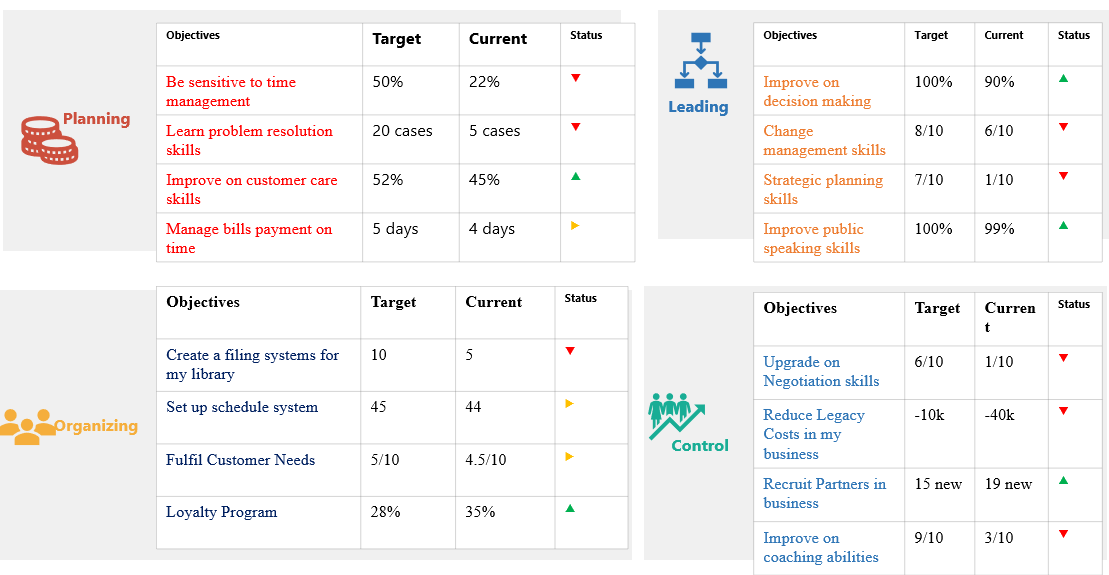A balanced scorecard is a performance management tool that provides a holistic view of an organization’s strategic objectives and how they are being achieved. It typically includes four perspectives: financial, customer, internal business process, and learning and growth. The balanced scorecard has been criticized for being overly complex and difficult to use. It can also be difficult to align all of the different perspectives to create a cohesive story. Additionally, the balanced scorecard does not necessarily provide actionable insights or suggest ways to improve performance. Overall, a balanced scorecard is a valuable tool that provides a comprehensive view of an organization’s strategic performance. When used correctly, it can help identify areas of improvement and guide decision-making in the pursuit of organizational excellence. However, it should be used with caution and not viewed as the only measure of success.
Benefits of this tool to executives and managers
Executives and managers can use the balanced scorecard to make better decisions about where to allocate resources and how to measure the success of their strategies. The financial component measures an organization’s fiscal performance against targets, while the customer and internal process components assess how well it is meeting the needs of its customers and employees, respectively (Quesado et al., 2018). The learning and growth component gauges how efficiently an organization is using its resources to improve its ability to meet future challenges.
The balanced scorecard has several benefits for executives and managers. First, it helps them identify areas where they need to improve their performance. Second, it provides them with a framework for measuring their progress and identifying areas where they need to make more improvements. Besides, it provides a guide for setting realistic targets and measuring progress against them. The managers can identify which strategies are most effective in achieving their objectives. It increases accountability and transparency for senior leaders in measuring performance and facilitates improved decision-making by providing a framework for understanding the costs and benefits of various options. Managers can define key success indicators (KSI) and track progress against them (Benková et al., 2020). Typically, the tool enhances overall organizational culture by ensuring that all employees understand how their actions impact the organization’s success. In the HR department, the tool enhances learning, growth, and development by providing a framework for measuring employee performance. Lastly, the tool improves communication within an organization by identifying how best to communicate key information across functions.
However, the balanced scorecard has come under criticism for a number of reasons. Firstly, it is often difficult to develop a meaningful set of measures that can be used to track performance. Secondly, the balanced scorecard can be overly complex and difficult to use, and most managers previews it as a technical and complex tool. Finally, it may not be as effective in tracking performance as other methods such as financial metrics. Although, the scorecard is a useful tool for monitoring performance,
it does have limitations. It should be used in conjunction with other measures to ensure that the overall goal of company performance is being achieved.
Categories
A balanced scorecard tracks its performance in four key areas: financial, customer, internal process, and learning and growth. Each of these areas is further divided into categories that help track progress and identify areas of improvement.
- Financial – This category includes metrics such as revenue, profit, and shareholder value. Organizations can quote facets such as revenues increased by $1 million, net income increased by $500,000, profit margin increased from 20% to 24%.
- Customer – This category includes metrics such as customer satisfaction, churn, and loyalty. For instance, the churn rate decreased from 2% to 1.5%
- Internal Process – This category includes metrics such as turnaround time, quality of work, and employee productivity. For example, turnaround time decreased from 60 days to 45 days – Employees rated their quality of work as excellent or good in every category
- Learning and Growth – This category includes metrics such as employee engagement, training effectiveness, and innovation. For instance, employees produced an extra 10,000 units per month due to increased efficiency and better teamwork.
Personal Balanced Scorecard

Conclusion
Combatively, a personal balanced scorecard should be critical and formal. Ongoing review of the performance measures will help to ensure that the organization is meeting its objectives. A formal scorecard process provides a structure for tracking progress and can provide useful data for making decisions about organizational improvement. By being analytical and objective, a personal balanced scorecard will help to improve overall efficiency within an organization.
References
Benková, E., Gallo, P., Balogová, B., & Nemec, J. (2020). Factors affecting the use of balanced scorecard in measuring company performance. Sustainability, 12(3), 1178.
Quesado, P. R., Aibar Guzmán, B., & Lima Rodrigues, L. (2018). Advantages and contributions in the balanced scorecard implementation. Intangible capital, 14(1), 186-201.
 write
write